13.15 Managing Groups of Documents
Whether you’re a user responsible for twenty documents or a system administrator responsible for thousands of documents, you can use the Mass Document Operations Wizard to efficiently manage groups of documents. Using the wizard, you can perform all of the following tasks:
-
Move a group of documents to another library.
-
Share a group of documents with another user.
-
Copy a group of documents.
-
Delete a group of documents.
-
Assign a group of documents to a new author.
-
Modify the properties (subject, document type, and so on) of a group of documents.
This section contains the following topics:
13.15.1 Preparing for a Mass Operation
Before you can perform a mass operation on a group of documents you must have sufficient rights to the documents. If you have Manage rights, you’re called a librarian, and you can perform the mass document operations on all the documents in the library. If you’re not a librarian, you can only perform mass document operations on the documents to which you have rights. The following table shows which rights you must have to perform each operation:
13.15.2 Selecting Documents for the Mass Operation
Before you begin the mass operation, you must specify which documents you want to include. There are four methods you can use to select documents:
-
You can select the documents from a Find/Advanced Find dialog box in the Mass Document Operations Wizard.
-
You can select the documents from a Find by Example dialog box in the Mass Document Operations Wizard.
-
You can select the documents in a folder or your Mailbox before you open the Mass Document Operations Wizard.
-
You can specify the name of a file on disk that contains a list of document IDs.
Previewing the Results of a Mass Document Operation
When you use Find in the Mass Document Operations Wizard to specify which documents you want to move, copy, delete, or change, you can click the button (on the last dialog box in the wizard) to see a list of the documents that will be moved, copied, deleted, or changed based on the criteria you specified in Find. This makes it possible for you to review these results and verify that the criteria are accurate and select the correct documents. If not, you can return to the wizard and modify the Find criteria to expand or limit the documents included in the operation.
After You Perform a Mass Document Operation
If you make any changes to the author or sharing rights of a document, the original author of the document receives a mail message that notifies him or her of the change.
Using Mass Document Operations in Remote/Caching Modes
IMPORTANT:The Mass Document Operations Wizard is not available in Remote or Caching mode. You can perform the same tasks on individual documents while you’re in your Remote/Caching Mailbox, but not with groups of documents.
13.15.3 Acting as the Librarian
The system administrator can give users Manage rights to a library. When you have Manage rights, you are called a librarian, and you can perform mass document operations, such as changing document properties, moving documents, and so on, on all the documents in the library.
When a librarian performs a search, the Find dialog box displays an extra option: Apply Librarian Rights. When selected, this allows the librarian to find any documents created by other users that might not have been explicitly shared with the librarian. However, the librarian cannot perform a full-text search when using this option.
The librarian can see and modify all the properties of a document, such as author, creator, security, subject, document type, and so on, but the librarian can’t see the content of the document. (To see the content of a document, the librarian must have View rights for that version of the document.) If the librarian makes any changes to the author or sharing rights of a document, the original author of the document receives a mail message that notifies him or her of the change. This prevents the librarian from giving unauthorized users access to a document.
In addition to modifying the properties listed above, the librarian can also perform the following actions on all the documents in the library:
-
Delete a group of documents from the library.
-
Move or copy documents to a different library.
-
Change the document properties (author, document type, subject, an so on) of a group of documents in the library.
-
Change the sharing rights to a group of documents in the library.
-
Reset a document’s status.
-
Use the GroupWise third-party APIs to generate reports on all the documents in the library.
Librarian and Remote/Caching Modes
The librarian can see all the properties of a document while in Remote and Caching mode; however, the librarian can’t change the author or sharing rights of a document while he or she is using Remote or Caching mode.
Librarian and Older Versions of GroupWise
If a librarian accesses a library using an older version of the GroupWise client, such as GroupWise 5.1 or 5.2, he or she does not have librarian access to documents, because neither the Manage right nor the librarian role existed in earlier releases of GroupWise.
13.15.4 Copying a Group of Documents
You can copy groups of documents using the Mass Document Operations Wizard. To copy a group of documents you must have View rights to each document, or you must be a librarian for the library. In addition, you must have Add rights in the library to which you want to copy the documents.
When you copy a group of documents, all versions of the document are copied. In the destination library, each copy of the document receives a new document number, but the document retains the same version number that it had in the source library. For example, if document #458 had a version one, two, and five in the Marketing library and you copy it to the Sales library, it would become document #459 (or whatever the next number is) in the Sales library, but it would still have a version one, two, and five. GroupWise copies all the document properties, including document activity and custom fields, to the destination library and stores them with the document; however, the custom fields do not display in Document Properties if the destination library doesn’t contain the field. When you copy documents, document references are not updated.
This section contains the following topics:
Copying a Group of Documents Selected with Find by Example
-
Click > .
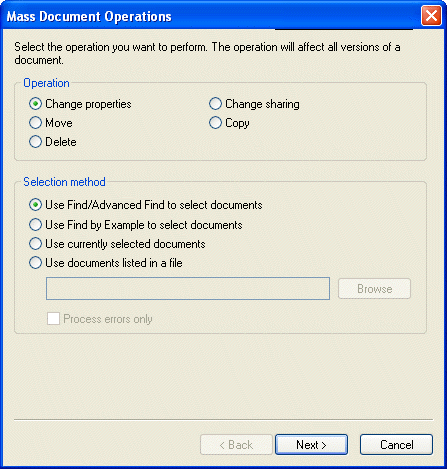
-
In the Operation group box, click .
-
In the group box, click , then click .
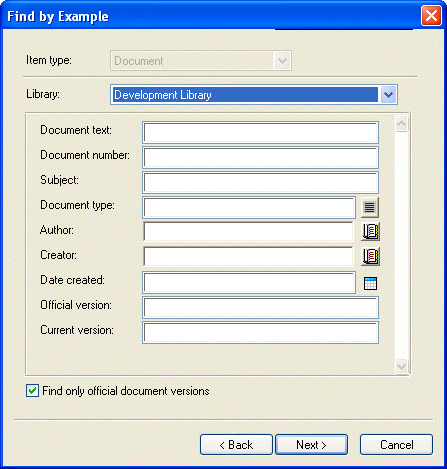
-
In the drop-down list, click the library you want to search.
-
In each field, specify the information you want to look for.
-
Click .
-
In the list box, select the destination library, then click .
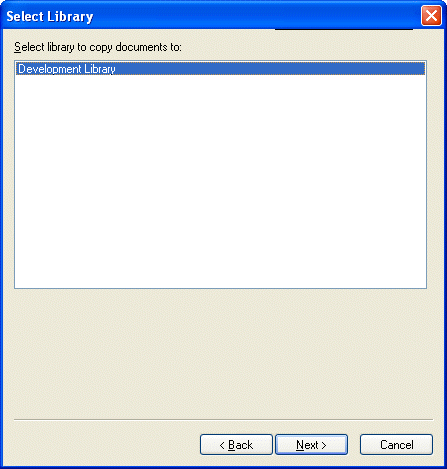
-
Click Preview to see a sample of the documents that will be copied based on the Find criteria you specified.
You can click at any time in the Find Results dialog box to cancel the preview.
-
Specify the directory where you want to save the log file.
You can click to see the outcome of the move without actually copying the documents.
If you are a librarian in the destination library, you have two additional options on the Log page of Mass Document Operations. Fields lets you choose whether or not to validate the property fields of the documents you are copying or moving. Allow lets you choose to bypass any validation errors.
-
Click to copy the documents.
Copying a Group of Selected Documents
-
In your Mailbox or folders, select the document references for the documents you want to copy.
-
Click > .
-
In the group box, click .
-
In the group box, click , then click .
-
In the list box, click the destination library, then click .
-
Specify the directory where you want to save the log file.
You can click to see the outcome of the copy without actually copying the documents.
If you are a librarian in the destination library, you have two additional options on the Log page of Mass Document Operations. Validate Document Property Fields lets you choose whether or not to validate the property fields of the documents you are copying. Allow Documents With Validation Errors To Be Created or Updated lets you choose to bypass any validation errors.
-
Click to copy the documents.
Copying a Group of Documents Listed in a File
-
Click > .
-
In the group box, click .
-
In the group box, click .
-
Specify the name of the file that contains a list of documents you want to copy, then click .
You can specify any text file (ASCII or ANSI) as the source file for a copy operation as long as the file contains a list of document IDs. If you’re creating a file, make sure that each document ID is at the beginning of a line and that there is only one document per line.
If the file you specify is a log file from a previous copy operation, you can click and GroupWise processes only the documents that generated errors during the previous session.
-
In the list box, click the destination library, then click .
-
Specify the directory where you want to save the log file.
You can click to see the outcome of the copy without actually copying the documents.
If you are a librarian in the destination library, you have two additional options on the Log page of Mass Document Operations. lets you choose whether or not to validate the property fields of the documents you are copying. lets you choose to bypass any validation errors.
-
Click to copy the documents.
13.15.5 Moving a Group of Documents
You can move a group of documents to another library using the Mass Document Operations Wizard. To move a group of documents, you must have View and Delete rights for each document you want to move, or you must be a librarian for the selected library. In addition, you must have Add rights for the destination library.
The documents you select for the move operation can be stored in multiple libraries on different post offices. GroupWise moves all versions of the selected documents and all document properties, including document activity and custom fields. If the destination library doesn’t contain one or more custom fields that exist in the source library, GroupWise moves the value for the custom field and stores it with the document in the new library; however, the value does not display in Document Properties until the system administrator adds that custom field to the destination library.
This section contains the following topics:
Notifying Authors and Users of Moved Documents
When the move is complete, GroupWise sends a message to you that contains a list of all the moved documents. In addition, GroupWise sends a message to the author of each moved document that shows the document’s new location. If a user is the author of multiple moved documents, the message contains a list of all his or her moved documents and the new location of the documents. Other users, who are not authors of the document, are not notified that the document was moved.
GroupWise automatically updates any document references to moved documents at the end of the move process. However, if a document reference is attached to a mail message, GroupWise does not update the reference. Instead, when a user clicks the attached document reference, a message displays that explains the document was moved and gives the new location of the document.
Moving a Group of Documents Selected with Find by Example
-
Click > .
-
In the group box, click .
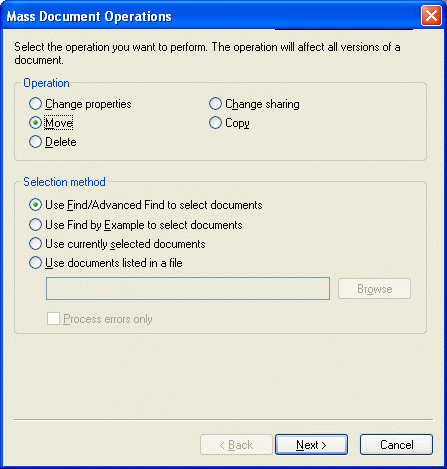
-
In the group box, click , then click .

-
In the drop-down list, click the library you want to search.
-
In each field, specify the information you want to look for.
-
Click .
-
In the list box, click the destination library, then click .
-
Click to see a sample of the documents that will be moved based on the Find criteria you specified.
You can click at any time in the Find Results dialog box to cancel the preview.
-
Specify the directory where you want to save the log file.
You can click to see the outcome of the move without actually moving the documents.
If you are a librarian in the destination library, you have two additional options on the Log page of Mass Document Operations. lets you choose whether or not to validate the property fields of the documents you are copying. lets you choose to bypass any validation errors.
-
Click to move the documents.
Moving a Group of Selected Documents
-
In your Mailbox or folders, select the document references for the documents you want to move.
-
Click > .
-
In the group box, click .
-
In the group box, click , then click .
-
In the list box, click the destination library, then click .
-
Specify the directory where you want to save the log file.
You can click to see the outcome of the move without actually moving the documents.
If you are a librarian in the destination library, you have two additional options on the Log page of Mass Document Operations. lets you choose whether or not to validate the property fields of the documents you are copying. lets you choose to bypass any validation errors.
-
Click to move the documents.
Moving a Group Documents in a File
-
Click > .
-
In the group box, click .
-
In the group box, click .
-
Specify the name of the file that contains the list of documents you want to move, then click .
You can specify any text file (ASCII or ANSI) as the source file for a move operation as long as the file contains a list of document IDs. If you’re creating a file, make sure that each document ID is at the beginning of a line and that there is only one document per line.
If the file you specify is a log file from a previous move operation, you can click and GroupWise processes only the documents that generated errors during the previous session.
-
In the to list box, click the destination library, then click .
-
Specify the directory where you want to save the log file.
You can click to see the outcome of the move without actually moving the documents.
If you are a librarian in the destination library, you have two additional options on the Log page of Mass Document Operations. lets you choose whether or not to validate the property fields of the documents you are copying. lets you choose to bypass any validation errors.
-
Click to move the documents.
13.15.6 Changing the Properties of a Group of Documents
As you manage your GroupWise documents, you often need to change the properties of several documents at the same time. For example, if an employee leaves the company, you might need to reassign all of his or her documents to another person, or if a new employee joins the company, you might need to give him or her access to several documents. You can use the Change Properties in the Mass Document Operations Wizard to efficiently perform these types of tasks (reassigning documents, changing document types, and so on) for groups of documents.
You can change the subject, author, or document type for a group of documents. In addition, you can change the value of any custom fields defined in the library. The fields you can modify vary depending on the location of the documents you select for the mass change operation. If the documents you select are all stored in the same library, you can make changes to system fields (subject, author, and document type) and custom fields. If the documents you select are stored in different libraries, you can modify only system fields. GroupWise imposes this restriction because the libraries you select might not contain the same custom fields.
This section contains the following topics:
Changing the Properties of a Group of Documents Selected with Find by Example
-
Click > .
-
In the group box, click .
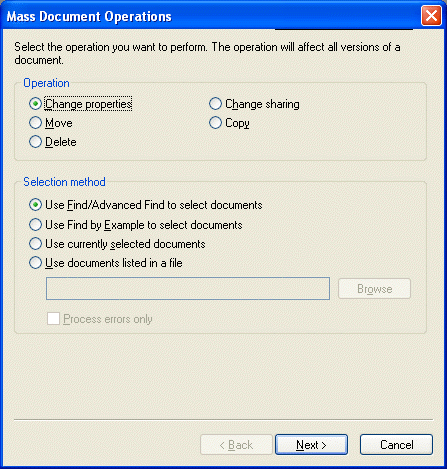
-
In the group box, click , then click .

-
In the drop-down list, click the library you want to search.
-
In each field, specify the information you want to look for.
-
Click .
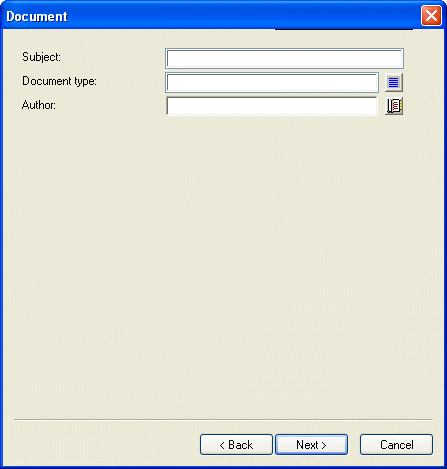
-
Specify new values for any of the document properties, then click .
-
Click to see a sample of the documents that will be modified based on the Find criteria you specified.
You can click at any time in the Find Results dialog box to cancel the preview.
-
Specify the directory where you want to save the log file.
You can click to see the outcome of the operation without actually changing the documents.
If you are a librarian in the destination library, you have two additional options on the Log page of Mass Document Operations. lets you choose whether or not to validate the property fields of the documents you are copying. lets you choose to bypass any validation errors.
-
Click to change the document properties.
Changing the Properties for Selected Documents
-
In your Mailbox or folders, select the document references for the documents for which you want to modify properties.
-
Click > .
-
In the group box, click Change .
-
In the group box, click , then click .
-
Specify new values for any of the document property fields, then click .
-
Click to see a sample of the documents that will be modified based on the Find criteria you specified.
You can click at any time in the Find Results dialog box to cancel the preview.
-
Specify the directory where you want to save the log file.
You can click to see the outcome of the operation without actually modifying the documents.
If you are a librarian in the destination library, you have two additional options on the Log page of Mass Document Operations. lets you choose whether or not to validate the property fields of the documents you are copying. lets you choose to bypass any validation errors.
-
Click to change document properties.
Changing the Properties for a Group of Documents in a File
-
Click > .
-
In the group box, click .
-
In the group box, click .
-
Specify the name of the file that contains the list of documents for which you want to change properties, then click .
You can specify any text file (ASCII or ANSI) as the source file for a change properties operation as long as the file contains a list of document IDs. If you’re creating a file, make sure that each document ID is at the beginning of a line and that there is only one document ID on each line.
If the file you specify is a log file from a previous session, you can click and GroupWise processes only the documents that generated errors during that session.
-
Specify new values for any of the document properties fields, then click .
-
Click to see a sample of the documents that will be modified based on the Find criteria you specified.
You can click at any time in the Find Results dialog box to cancel the preview.
-
Specify the directory where you want to save the log file.
You can click to see the outcome of the operation without actually modifying the documents.
If you are a librarian in the destination library, you have two additional options on the Log page of Mass Document Operations. lets you choose whether or not to validate the property fields of the documents you are copying. lets you choose to bypass any validation errors.
-
Click to change document properties.
13.15.7 Changing Sharing for a Group of Documents
You can give, modify, or remove a user’s access to a group of documents. You can do this two ways: you can modify a user’s rights in the existing Share List for the group of documents, or you can create a new Share List which will replace the existing Share List for each document in the group.
This section contains the following topics:
Modifying the Existing Share List
If you select , you can add, remove, or change a user’s rights to the group of documents without changing any of the rights you’ve given to other users. For example, you could grant a new employee rights to all the benefit documents in the library. This adds the new employee to the Share List for each document in the group, but it doesn’t modify the rights of any of the other employees.
If the user you want to add already has rights to one or more of the documents in the group, the rights you specify in the wizard replaces any previous rights this user had to the documents, but it does not reduce rights the user already has. For example, suppose you give Pam View rights for a group of documents which includes Document A, but Pam already has both View and Edit rights to Document A. In this case, GroupWise will give Pam View rights to all the documents in the group, including Document A, but GroupWise does not remove Pam’s Edit rights to Document A.
Replacing an Existing Share List with a New Share List
If you select , you can create a new Share List for each of the selected documents. This new Share List replaces the existing Share List, and only the users on the new Share List have rights to the selected documents.
Changing the Sharing Rights for a Group of Documents Selected with Find by Example
-
Click > .
-
In the group box, click .
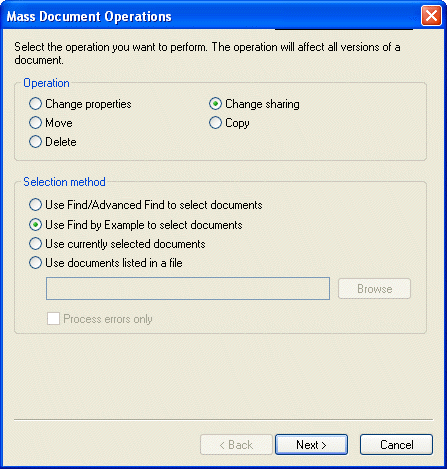
-
In the group box, click , then click .

-
In the drop-down list, click the library you want to search.
-
In each field, specify the information you want to look for.
-
Click .
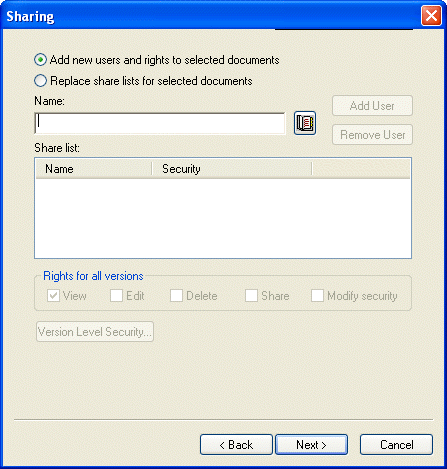
-
Click to modify the existing for each document in the group.
or
Click to create a new Share List to replace the existing Share List for each document in the group.
-
In the field, type the name of the user for which you want to modify sharing, then click .
-
In the , click the name of the user for whom you want to modify sharing rights.
-
In the group box, click the rights you want to give the user to the selected group of documents.
-
If you want to specify sharing rights for specific versions, click , specify the rights for each version, then click .
-
Click .
-
Click to see a sample of the documents that will be modified based on the Find criteria you specified.
You can click at any time in the Find Results dialog box to cancel the preview.
-
Specify the directory where you want to save the log file.
You can click to see the outcome of the operation without actually modifying the documents.
-
Click to modify the document sharing.
Changing Sharing Rights for Selected Documents
-
In your Mailbox or folders, select the document references for the documents for which you want to change sharing rights.
-
Click > .
-
In the group box, click .
-
In the group box, click , then click .
-
To modify the existing Share Lists for each document in the group, click .
or
To create a new Share List to replace the existing Share List for each document in the group, click .
-
In the field, type the name of the user for whom you want to modify sharing rights, then click .
-
In the , click the name of the user for whom you want to modify sharing rights.
-
In the group box, click the rights you want to give the user to the selected group of documents.
-
If you want to specify sharing rights for specific versions, click , specify the rights for each version, then click .
-
Click .
-
Click to see a sample of the documents that will be modified based on the Find criteria you specified.
You can click at any time in the Find Results dialog box to cancel the preview.
-
Specify the directory where you want to save the log file.
You can click to see the outcome of the operation without actually modifying the documents.
-
Click to modify the document sharing.
Changing Sharing Rights for Documents in a File
-
Click > .
-
In the group box, click .
-
In the group box, click .
-
Specify the name of the file that contains a list of the documents for which you want to change sharing rights, then click .
You can specify any text file (ASCII or ANSI) as the source file for a change sharing operation as long as the file contains a list of document IDs. If you’re creating a file, make sure that each document ID is at the beginning of a line and that there is only one document per line.
If the file you specify is a log file from a previous operation, you can click and GroupWise processes only the documents that generated errors during the previous session.
-
Click to modify the existing Share Lists for each document in the group.
or
Click to create a new Share List that will replace the existing Share List for each document in the group.
-
In the field, type the name of the user for whom you want to modify sharing rights, then click .
-
In the , click the name of the user for whom you want to modify sharing rights.
-
In the group box, click the rights you want to give the user to the selected group of documents.
-
If you want to specify sharing rights for specific versions, click , specify the rights for each version, then click .
-
Click .
-
Click to see a sample of the documents that will be modified based on the Find criteria you specified.
You can click at any time in the Find Results dialog box to cancel the preview.
-
Specify the directory where you want to save the log file.
You can click to see the outcome of the operation without actually modifying the documents.
-
Click to modify the document sharing.
13.15.8 Deleting a Group of Documents
You can delete a group of documents using the Mass Document Operations Wizard. To delete a group of documents you must have Delete rights to the documents, or you must be a librarian for the library. In addition, you must have Delete rights to the library from which you want to remove the documents.
When you delete a group of documents, all versions of the documents are deleted; however, the activity logs for the deleted documents are not removed. Document references that point to deleted documents are not deleted. If you click a document reference to a deleted document, a message appears telling you that the document has been deleted.
This section contains the following topics:
Deleting a Group of Documents Selected with Find by Example
-
Click > .
-
In the group box, click .
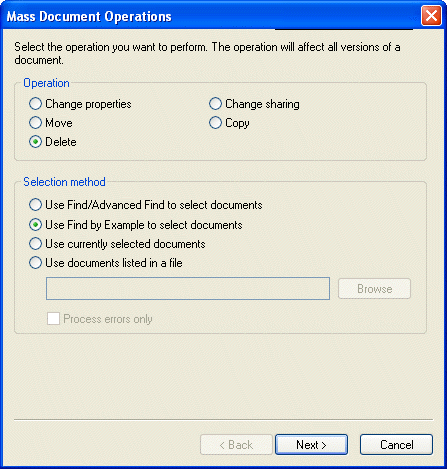
-
In the group box, click , then click .

-
In the drop-down list, click the library you want to search.
-
In each field, specify the information you want to look for.
-
Click .
-
Click to see a sample of the documents that will be deleted based on the Find criteria you specified.
-
You can click at any time in the Find Results dialog box to cancel the preview.
-
Specify the directory where you want to save the log file.
You can click to see the outcome of the delete without actually deleting the documents.
-
Click to delete the documents.
Deleting a Group of Selected Documents
-
In your Mailbox or folders, click the document references for the documents you want to delete.
-
Click > .
-
In the group box, click .
-
In the group box, click , then click .
-
Specify the directory where you want to save the log file.
You can click to see the outcome of the delete without actually deleting the documents.
-
Click to delete the documents.
Deleting a Group of Documents Listed in a File
-
Click > .
-
In the group box, click .
-
In the group box, click .
-
Specify the name of the file that contains the list of documents you want to delete, then click .
If the file you specify is a log file from a previous delete operation, you can click and GroupWise will process only the documents that generated errors during the previous session.
-
Specify the directory where you want to save the log file.
-
You can click to see the outcome of the delete without actually deleting the documents.
-
Click to delete the documents.